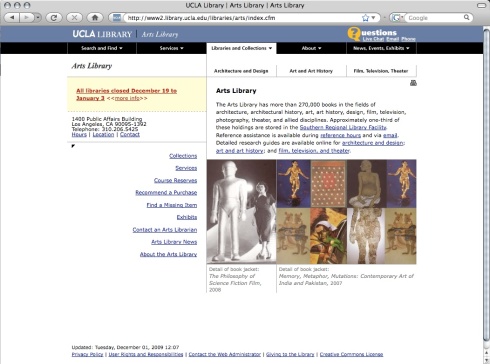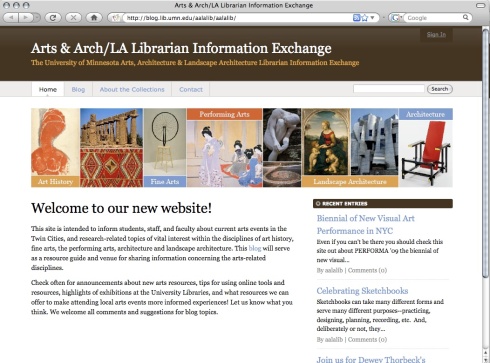You are currently browsing the tag archive for the ‘blogs’ tag.
And, we’re back to blogs…
The UCLA Arts Library is divided into three subject areas: Art and Art History, Architecture and Design, and Theater, Film and Television. For this reason, the UCLA Arts Library has three blogs. The template is identical for all blogs, which provides consistency, and shows a relationship between them. Each blog is accessible from the Arts Library website under the blogs section of each respective heading. The Art and Theater blogs are also linked to one another on their blogs, but the Architecture blog is not (perhaps because it is newer).
Having dealt with the issue of representing multiple departments through blogs, it is understandable that the UCLA Arts Library would opt for three separate blogs rather than lumping everything into one. It was also a feasible option because each of the three sections has its own librarian or staff member to update the blog content (so it doesn’t fall into the hands of one individual, in which case there would surely only be one blog). These blogs were not started at the same time. The Theater, Film and Television blog came first, in May 2008, the Art and Art History blog started shortly after, in June 2008, and the Architecture and Design blog just started in September 2009.
The content is similar across all three blogs, which makes me wonder why the three separate blogs are necessary at all. The blogs contain updates on library tools and resources (particular attention given to the ARTstor database), upcoming exhibitions in the library, and the occasional arts news post. ARTstor posts especially dominate the Art and Architecture blogs, and I would recommend they embed an RSS feed to the ARTstor blog rather than repeat content. Chances are, ARTstor users are already receiving these ARTstor updates. If you remove the ARTstor posts, what remains is pretty slim. As I said with the Yale Arts Library blog, they would benefit from the addition of short bibliographies, highlights from the collections, or recent acquisitions. They could use a few more images as well, for aesthetic reasons, as the blogs are currently a bit dull. If I were a arts student at UCLA, I would probably subscribe to the art and art history blog, but I’m not sure I would get much out of it.
The best art library blog I have come across belongs to the Yale Arts Library. The blog posts themselves are just mediocre, but the additional pages including research tools, Yale resources, and links provide an abundance of useful information. This is an excellent example of a blog as a one-stop-shop. The only thing it’s missing is a widget for searching the Library’s catalog. If the Library’s homepage was a wreck, I’d use the blog instead, but it is Yale and the Arts Library’s homepage happens to be quite pretty and user friendly.
Visitors can find the link to the blog in the About the Library dropdown menu. If they want users to find it, they really should move it somewhere more visible (I see a perfect place for it in the right-hand column). Once users get to the blog, it is easy to navigate. The simple two-column grid places recent posts, a category cloud, top posts, the blogroll, and additional useful links on the right side of the page. These categories remain when moving through the various other pages on the site, which allows for quick navigation back to blog content. One additional category that would facilitate browsing would be to include the archive, which would allow users to browse by date.
One area that needs improvement is the overall content of the blog posts. Nearly all entries are links to news or journal articles. Perhaps it’s the librarian in me, but I’d like to see updates on recent acquisitions or highlights from the collection. What they lack in blog content they make up for with their links and additional tools and resources. Any first year student would be grateful for the library how-to movies and step-by-step tutorials, that are easy to find and use.
This blog has made me realize one general drawback to blogs: spam comments (or as with the Yale Arts Library blog, a random reference question posted in the comments section of the Research Tools page: “I am looking for a yale 1800 cream pitcher, with the number 500 and a half on the bottom of it.” Why would you post that on the blog?). While comments can be monitored, that takes staff time, but I think it is time well spent. If your patrons want to participate in group discussions or post their own comments not related to the blog, maybe Facebook is the better alternative.
In August I left my job as intern to the Arts, Architecture, and Landscape Architecture Liaison at the University of Minnesota, in order to pursue my MLIS. My final project before I left was to create a blog for the library. Starting the blog was easy (and finding ARTstor images to design the header montage was a blast), but finding time to write blog entries and getting the attention of students, faculty, and staff were more challenging tasks. In creating the blog it was important to consider the diverse audience (five different departments: art history, fine art, architecture, landscape architecture, and theater/dance) in order to determine the appropriate content.
All blogs at the UofM are hosted by the University Libraries’ UThink Blogs, run with Movable Type 4.25. For the Arts & Arch/LA Librarian Information Exchange blog I selected a professional website template, which appears less like a blog, and more like a website, and allows for multiple pages including a home page, blog, and about the collections and contact pages. This template is easily navigable, particularly with the links to recent blog entries visible on every page. It’s even easy for non-tech-savy professors to use.
The Arts & Arch/LA Librarian Information Exchange blog contains information on new library resources, exhibitions at the University Libraries, tips for using online tools, and other relevant arts information. Each post provides great information with links to the library catalog and resources, but the blog is updated infrequently (only a couple times each month). In order for a blog to stay relevant and attract users, it needs to provide continually updated content. As I mentioned before, the hardest task is getting an audience, and without sufficient content, they will not revisit the blog.
Marketing the blog is also necessary to build a reader base. When the blog was first created, an email was sent to all students, faculty, and staff in all five departments notifying them of the blog. However, feedback was minimal and the RSS subscription rate still remains in the single digits. Perhaps one issue is that the blog is not advertised on the library website. This is challenging to do since the visual and performing arts collections are located in the main library and the architecture/landscape architecture collections have their own library across campus, so there is not one single physical or web location (which was one of the reasons we created the blog in the first place). The Librarian includes a link to the blog in her email signature, but only students and faculty who email reference questions ever see that (and how many, for that matter, even notice it?). A blog was a great idea, but is it worth it if it’s rarely read?
It’s easy to create a blog, especially with the abundance of blog templates, but as you can see it’s not always easy to find time to update them, and it’s even more difficult to market your blog to readers.







